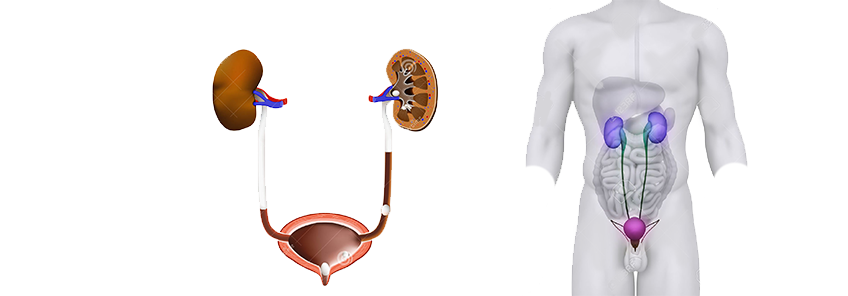Kidney (Urinary) Stone

- Most stones are made up of calcium. Overactive parathyroid gland is one of the causes of excess calcium in blood.
- High calcium in urine combined with less water intake increases the risk of stone formation.
- Increased concentration of oxalate, cystine, or uric acid in urine may also lead to urinary stones.
- Dietary habits like low water intake, excess consumption of salty, oxalate-rich food, excessive calcium supplementation may also increase the risk.
- Family history of kidney stones increases the risk.
- Prior history of kidney stone increases the risk.
- Recurrent urinary tract infections, kidney scars or cysts, etc.
- Some medications like chemotherapeutic agents etc. may also lead to kidney stone formation.
- Pain: A stone that is trapped in the kidneys or ureter and blocks the flow of urine may cause flank pain, which may radiate towards lower abdomen and groin. The pain ranges from mild to severe; and be intermittent. Severe pain, also known as renal colic, usually lasts for 20 to 60 minutes and makes you feel sick due to pain.
- Blood in urine: It is caused by the friction inside the ureter or bladder by the moving stone.
- Infection: Urine infection causes symptoms like fever, increased frequency of urination, burning urination, nausea and vomiting, etc.
- If stones block urine flow from both kidneys for long time, it causes swelling of kidneys (hydronephrosis) which can lead to kidney failure.
- Severe pain on sides of abdomen or sides of lower back;
- Bloody urine;
- Painful urination;
- Fever; or
- Nausea, vomiting.
- Blood tests: to check kidney function and the level of chemicals like calcium, uric acid etc.
- Urine tests: to look for blood in urine, infection and some crystals.
- Analysis of stone if passed in urine.
- Imaging like CT Scan, ultrasound, X-rays, etc.
- Drink plenty of fluids throughout the day and night. This is more important if you live in hot and humid climate.
- Take the medications prescribed to prevent future kidney stones, especially uric acid stones.
- Reduce the amount of oxalate in your diet like cabbage, coffee, spinach, etc.
- Reduce the amount of salt you consume.
- Eat moderate amounts of food with calcium, such as milk, cheese, and other dairy foods.
- Treat conditions that predispose to kidney stone, example overactive parathyroid gland that causes high calcium levels in blood.
Urinary stones are formed anywhere in the kidneys, the tubes draining urine (ureters) or the urinary bladder. These are formed from the accumulation of substances like calcium, oxalate, cystine, or uric acid which are present in urine.
If these stones become bigger, they may get trapped anywhere in the urinary tract blocking the urine flow. The occurrence is more common in men than women and in between the ages 20 to 40 years and may become very painful. About half of people who had kidney stone have a chance of recurrence at some point in their life, so preventive measures are very important.
Risk factors
The cause of urinary stone formation is usually unknown. However, there are some known risk factors. These include:
Symptoms
Urinary stone stones may remain asymptomatic. The symptomatic people can experience the following symptoms:
When to seek medical care
Seek immediate medical care if you experience any of the following:
Diagnosis
History, examination and further tests help diagnose urinary stone.
Treatment
Treatment of kidney stone depends upon size of the stone, location, its cause (if known) or complications.
Treatment of the cause of the stone is done through the correction of chemical abnormality, such as by reducing blood calcium levels and treatment of infection. Treatment of complications due to stone are management through pain medicine, antibiotics for infection and the treatment for kidney failure.
Stone removal:
A small stone may pass in urine by itself. Drinking plenty of water will help. Larger stones are removed by breaking down into smaller pieces (lithotripsy) or by surgery (through a small hole in skin and kidney or open surgery) or by endoscopy.
Prevention
Some of the measures to prevent formation and recurrence of kidney stones are:



Send us your feedback on this article